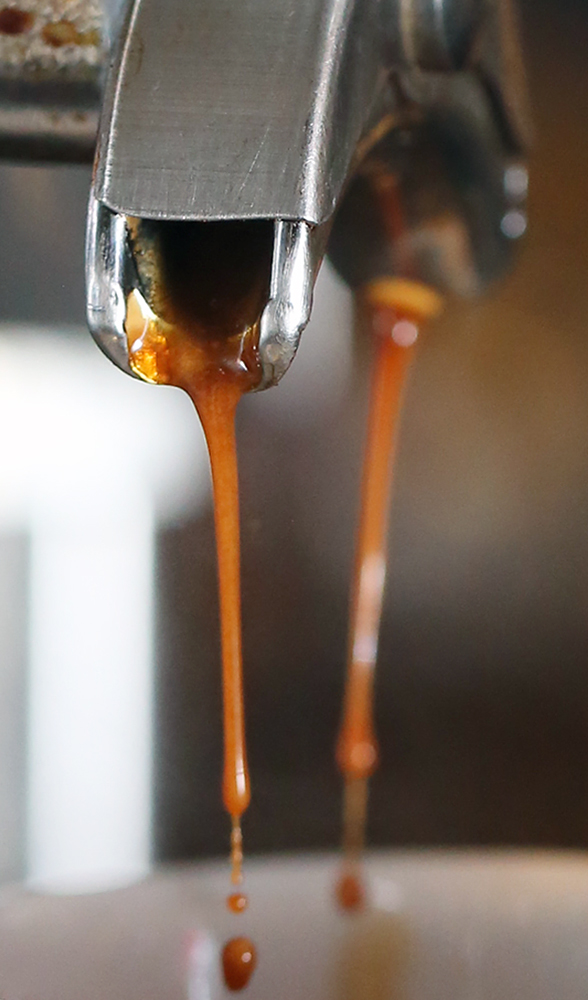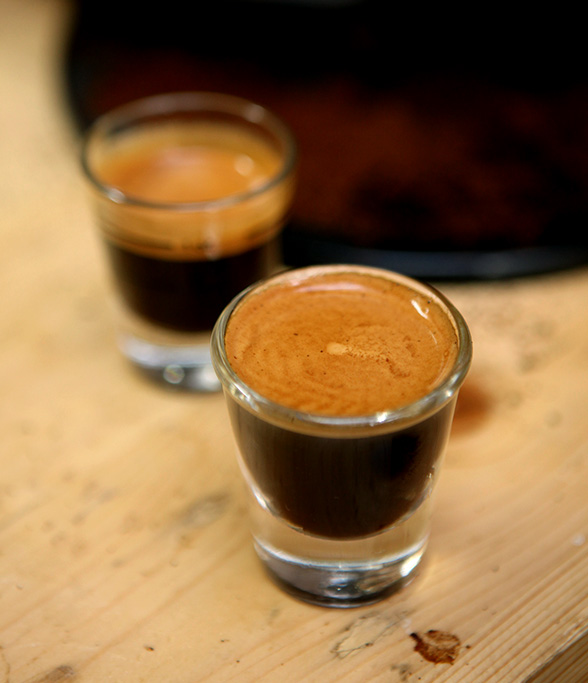So here you are behind your fantastic high end espresso machine. All shiny chrome & beautiful lights, with your excellent single origin super expensive coffee ready to go.
You manual dose, press the button & stop the pour at 20-30ml.
It looks fantastic with lovely tiger stripes & a wonderful hazelnut brown crema.
But the feedback from your customers is sometimes good, sometimes bad. Some complain it is acidic, some complain it is bitter, some complain it is watery, some say it is beautiful.
You think they don’t understand the product.
But actually they are right!
So what has gone wrong?
This is a common situation in caffes in Indonesia today. The enthusiasm and passion are wonderful. But, let’s be honest here, the fault lies with the Barista. They think they are rock stars & they bask in the adulation of their fans. They can do no wrong.
But in reality they haven’t done their homework. They have found out all about the green bean origin, the roasting profile, the nice story regarding the coffee.
So what have they missed?
The technical information as to the correct extraction profile for their coffee. They have been lazy.
Let’s start at the beginning with some basic technical information regarding beans, espresso extraction & espresso machines in general.
Espresso Machines
There are 2 main kinds of espresso machine:
- Continuous Flow machine pioneered by Faema. There are variants but the principals are the same
- Direct connection from boiler to group head. This can be with 1 boiler total, 2 boilers with 1 dedicated to the group heads or 1 main boiler with individual boilers for each group head. Again principals are the same.
There are also 3 different kinds of delivery system for water to the group head:
- Rotary pump which provides a flat pressure delivery that can be set at a predetermined level
- Vibratory pump which has a pressure curve
- Lever machine which uses a mechanical spring loaded system that again delivers a pressure curve
Which of these is best? Depends on your personal preference.
A good barista can produce excellent espresso on any of these machines. So everyone needs to stop blaming the machines.
Roasting Profile & Bean Characteristics
Any good roaster will know that each coffee is different and benefits from different roasting profiles.
The beans could be acidic in nature, Have delicate aromatics, spicy characteristics, chocolaty notes. There is a great variance in beans from different regions and different growers. As such the roasters job is to bring out the best in the beans through a careful application of the correct roasting profile for that bean.
Variation in the profile will result in different characteristics such as the acid/ bitterness ratio, perceived sweetness & aromatic profiles.
As such a good roaster will test any batch of green beans with a few different roasting profiles to try and get the results they want. Generally for espresso we will be looking for an acidity/ bitterness balance, moderate sweetness & medium body. Preferences of taste may vary this.
Extraction profile
So back to our situation where we have fantastic coffee, the equivalent of a Ferrari for an espresso machine but cannot produce a consistent espresso. Why not? The answer is actually incredibly simple. We do not know the best extraction for that particular coffee!
The roaster has done his homework to get the best roasting profile for the coffee then the barista comes along and doesn’t do any testing of the different parameters & just assumes that any extraction he makes will be great as long as it is the correct ml.
I have seen it happen so often. The barista will vary the dose, ignore the extraction time & just focus on the ml. This does not give you a consistent quality result.
There are many parameters that affect an espresso but most of them are not relevant to our discussion since they are hard to change on most machines. Also they don’t necessarily need to be changed.
The 4 we will discuss are:
Volume – the amount of liquid extracted into the espresso cup. This directly relates to the body of the espresso as the more volume extracted, the more watery the resultant espresso. This does not directly relate to the acidity, sweetness or bitterness of the espresso although it can make it harder to detect the characteristics if they are diluted or concentrated excessively.
Time – the amount of time it takes to extract the volume into the cup. This does directly relate to the acidity, bitterness and sweetness of the espresso. As a general rule, the shorter the extraction the more acid the result. The longer the extraction the more bitter the result. Sweetness is most apparent when the acidity & bitterness is in balance
Dose – the amount of ground Coffee in the filter basket. This directly relates to the intensity of the characteristics & the body of the espresso. The higher the dose, the higher the intensity of the characteristics & the higher the body. The problem is that with higher dosing the characteristics that are accentuated are the dominant ones such as chocolate or caramel not the lighter ones such as jasmine or honey
Grind – the fineness of the grains of the ground coffee. This affects how fast the water passes through the ground coffee and consequently the amount of the solid particles and oils that are in the finished espresso. This will affect the flavour profile, body & acidity/ bitterness balance.
As you can see from the above all these variables are inter-related making it very hard to arrive at a value judgment as to what are the best parameters for the perfect espresso from any coffee.
So what we are looking for is a perfect balance between all these variables to produce an espresso that has a balance between the acidity & bitterness allowing the sweetness to be apparent, while allowing all the favourable characteristics to be perceived. In other words a harmonious balance.
You can guess at it and maybe you will get lucky, but I suggest you need to actually do a full extraction profiling.
How?
Well you will need a set of scales and a pre-determined volume that you will use for every extraction. I suggest 25ml. At least 1kg of coffee & every espresso must be made by the same person to keep the tamping consistent.
Create a chart like the following & test every single extraction noting the acidity, bitterness, sweetness, body & perceived characteristics.
It will take you all morning. I suggest only doing 1 profiling session per day to prevent palate overload.
You will notice that every coffee has a specific sweet spot. A position on the chart above where the acidity, bitterness & sweetness are all in balance and a greater range of aromas and flavours can be perceived. For example a particular Aceh Gayo roasted medium dark will have its sweet spot at 8 grams & 28 seconds. You will also notice from the chart that if we reduce or increase the gramming by 0.5g it is still pretty close & an acceptable espresso. As we decrease or increase the timing by 0.5 seconds we will get a variance in the acidity/ bitterness ratio that is also still acceptable. This gives us margin for error.
If, however we go further out than these values we consequently affect the espresso in a negative way.
We have run experiments in our laboratory to assess the impact of variation of the parameters on the profile of the espresso. Often using blind tasters to keep the results neutral.
The results we got were interesting in that they went against popular wisdom but are extremely logical when you think about it:
- First experiment was to extract espresso from a known coffee at the correct seconds and vary the volume over 4 different extractions of 15ml, 30ml, 45ml, 60ml by changing the grind setting and keeping the grams constant
- We found that regardless of the volume the acidity/ bitterness balance remained the same thereby keeping the overall characteristics of the espresso very close in the different extractions.
- The primary effect of the different volumes was the differing body of the different volumes
- Second experiment was to extract from a known coffee at the correct seconds and vary the volume over 4 different extractions of 15ml, 30ml, 45ml, 60ml by changing the dosing while keeping the grind setting the same
- We found that the lowest volume espresso had a very high intensity with extreme acidity & bitterness (still balanced but very sharp & intense) and the only flavour perceived was chocolate. The highest volume espresso had rather muted characteristics while the mid volume had the most smooth rounded result
- Body varied proportional to the volume as would be expected with 30ml being perceived as medium
- Third experiment was to extract a known coffee at 25ml volume and vary the grind to produce 4 different timings, 20secs, 24 secs, 28 secs, 30 secs
- At the fastest extraction speed the espresso was highly acidic while at the longest, 30secs the bitterness was starting to dominate. 28 secs produced the balanced result as expected
- The body varied proportional to the speed of the extraction with the fastest extraction producing the lightest body but by 30 seconds the body was becoming lighter again. 28 produced a medium body as expected
- Fourth Experiment was to extract a known coffee at 25ml volume and vary the dose to produce 4 different timings, 20 secs, 24secs, 28 secs, 30secs
- At the fastest extraction times again the acidity was pronounced, with the slowest setting tending to make the bitterness dominant
- The intensity of the flavours and aromas was muted in the fast extractions & too elevated and harsh on the slowest extraction
As we can see from these experiments maintaining a set dose & timing for the extraction are the two most important parameters for the taste of the espresso. As soon as the dose or timing become too small or too large the balance is gone and the resulting espresso is not as good as it can be or even highly unpleasant.
We can also see that bigger is not necessarily better. Higher doses resulted in elevated, aggressive acidity & bitterness & masking of some aromas and flavours. This is not to say that some coffees will not benefit from a high dose. But you have to assess the extractions to find out. Simply assuming a high dose is a good thing is just being lazy.
So in summary, it is the Baristas fault if the espresso is unbalanced or unpleasant as they are the ones responsible for knowing the extraction parameters and making sure they keep it where it should be. It is rarely the fault of the machine or the coffee.
So let’s all start taking responsibility for the coffee we serve to our customers and make a better product by doing the hard work to ensure we know what we are doing.
Also, one last note: please do not believe anything I have written.
Test it yourselves !
* * *
Note : The copyright of the article solely owned by the author, a barista, National Barista Competition Judge, and many more.




 Brewing coffee is truly a combination of art and science. It takes knowledge, skills, and most importantly, passion for a perfection. The contents of this coffeelicious blog is created by me, who effortlessly cool and adorable by nature. Trusting me at your own risks.
Brewing coffee is truly a combination of art and science. It takes knowledge, skills, and most importantly, passion for a perfection. The contents of this coffeelicious blog is created by me, who effortlessly cool and adorable by nature. Trusting me at your own risks.


Wow, ternyata barista lokal msh bnyk yg blm nerapin strength & yield ratio ya dan blame it all on the machine.. -__-‘
found this article from cikopi archive! very nice article and humble explanation. by the way, Anonymous barista? hmm.. A.W.T ? coffee story yaa? hohoho! good one Pak!
WOW!!!!!
very nice explanation
http://tarryhan.wordpress.com/
You. Are. Awesome. Dude. You’re like my character that comes alive (I write a story about barista and coffee). Not only baristas, but everyone must know about this fact. Great job, anyway!
I like this. Goog job.
Next time kudu dibuka nih who’s the “penulis tamu”
This is it!!!!
This is a very very helpful article…
This is a vey humble article with a tons of knowledge…
This is the best barista article i ever read forever..
This is a great job…
Thanks Uncle TW for sharing with us
Please don’t stop writing for us.. you are always welcome…
really really love this article. awesome…..
Wow what a good article to share. Love it! I know how to appreciate my cup of coffee better.
Like this Article so much.
As always superb writing-journalism skill from you, Pak Toni
Keep Creative.
I like this
Nice article and well explain
harus di baca dan di pahami para barista.. luar biasa artikel ini..
thx pak tony.
Articel yang sangat bermanfaat bagi para Barista! Disarankan utuk di bookmark page ini dan diterapkan
Maju terus cikopi.com !
Kudu cari rumus yang tercocok dengan selera untuk tiap kopi, dan kopi juga pasti berubah seiring umurnya.